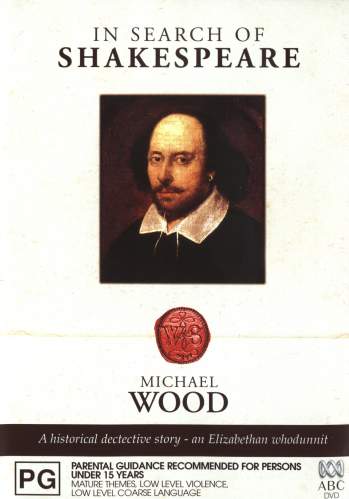In Search of Shakespeare (2003) |
|
In Search of Shakespeare (2003) |
|


|
| BUY IT |
| General | Extras | ||
| Category | Documentary | Main Menu Audio | |
| Rating |

|
||
| Year Of Production | 2003 | ||
| Running Time | 215:08 (Case: 220) | ||
| RSDL / Flipper |
Dual Layered Dual Disc Set |
Cast & Crew | |
| Start Up | Ads Then Menu | ||
| Region Coding | 1,2,3,4,5,6 | Directed By | David Wallace |
|
Studio
Distributor |
 Roadshow Home Entertainment |
Starring | Michael Wood |
| Case | Amaray-Transparent-S/C-Dual | ||
| RPI | $39.95 | Music | Howard Davidson |
| Video | Audio | ||
| Pan & Scan/Full Frame | None | English Dolby Digital 2.0 (224Kb/s) | |
| Widescreen Aspect Ratio | 1.75:1 | ||
| 16x9 Enhancement |
 |
||
| Video Format | 576i (PAL) | ||
| Original Aspect Ratio | 1.75:1 | Miscellaneous | |
| Jacket Pictures | No | ||
| Subtitles | None | Smoking | No |
| Annoying Product Placement | No | ||
| Action In or After Credits | No | ||
"There was a star danced, and under that was I born." So says Beatrice, in Act II, Scene I of William Shakespeare's Much Ado About Nothing. Although he gave these words to one of his characteristically strong and interesting female inventions, it is also a fitting epithet to the mystery shrouded life of the Bard himself.
If you have not already seen this outstanding historical production on the life of William Shakespeare, allow me to strongly urge you to do so. It reveals an historical character in the full context of the political, social and cultural values of his time. Presenter Michael Wood, with a breathy, boyish enthusiasm, unfurls the stolid literary image of his subject to disclose the fully human individual underneath. Frequently disclosing newly discovered documents, he breathes into our understanding of Shakespeare much more than the usual reverential awe.
Wood presents instead young Will, the product of an upwardly mobile father John, who himself is not above a bit of nefarious wheeling and dealing on the side to fatten his pockets and his prestige. We learn not only of the rise, but also of the perilous fall of Will's father, each bitter experience becoming grist to the young poet and playwright's literary mill. From idyllic beginnings in his beloved Warwickshire, and a shotgun marriage to Anne Hathaway, he made his way to London, and all the intrigues of Elizabethan society. As Wood points out - these were dangerous times indeed, and England was subject to the strictest of martial law with deep religious division and espionage aplenty. As olde England is revisited, we learn of each significant site with an intimacy and sense of reality that I've rarely seen paralleled in a television series. Wood brings Shakespeare's world alive, finding the hidden corners of history that are still to be glimpsed amongst modernity's usurpal.
Travelling with the Royal Shakespeare Company, we witness excerpts from many of his best known works, frequently in authentic historical settings. Everything comes so alive as we see these superb performers glorifying his works in taverns and halls, in Hampton Court, and especially in recreations of Shakespeare's 2 theatres, The Globe and Blackfreyers. The theatre was a dangerous place in Shakespeare's times. It was intensely political, dangerously satirical and, so the authorities thought, potentially seditious. When they weren't being shut down by fear of the Plague or political censorship, playhouses like The Globe would, for a few months of the year, provide one of the great entertainments for all strata of English society. Nestled amongst the taverns, the bear pits and the whorehouses, each theatre would proudly fly its flags announcing to a knowing audience what kind of story to expect - a black flag if tragedy was on the menu, a white flag for comedy, and a red flag for historical epics.
Shakespeare's fortunes lay in the hands of two political eras - the Elizabethan rule and the Jacobean reign of James I. Both were effectively police states, and there were times, Wood points out, when our playwright sailed dangerously close to the wind. As the demise of some of his contemporaries show, life was frequently cheap, and political assassination was a common expediency. Our bard knew great achievements, but also deep dangers in his tumultuous life. This documentary reveals his earthy feet of clay as well as his high mindedness in a refreshingly humanistic approach to the subject matter.
There are two discs in this set with two episodes on each disc.
DISC ONE
This episode covers Shakespeare's baptism and idyllic boyhood in Stratford Upon Avon. We learn about his mother's and father's pedigree and the changing of his family's fortune, resulting in young Will having to leave school early to apply a trade. The surrounding history and religious upheavals of the time are also set into context - a thematic thread that dominates both our subject's life and this documentary.
How did a teenaged father of negligible education rise to become a thespianic demi-god? This episode further examines Shakespeare's life in the treachery of Elizabeth I's England. It starts to reveal his extraordinary magpie mind - how he retains tiny threads and drifts of situations and circumstances, and begins to weave them into theatrical magic. We see how, in 1592, his Henry VI becomes a blockbuster, making him a kind of George Lucas of his day.
DISC TWO
With his family still ensconced in Warwickshire, and Shakespeare on tour with his players, we can only imagine his grief in learning of the death of his eleven year old only son, Hamnet. His sonnets are examined in depth during this episode, with Wood challenging the theory that much of these works reveal a theme of homosexuality, in favour of stating that these words of love were an outpouring of his ardour and grief for his bemourned son. That being said, there is examination of his attraction to a young male aristocratic patron, and allusions to a dark mistress - possibly a Viennese Jewess - just before he pens Merchant of Venice. Political intrigue arises again with examination of Shakespeare's involvement in the unsuccessful Essex conspiracy. Further intrigue surrounds the commentary on his work by a favoured cousin who also happens to be a wanted Catholic priest.
Theatre is again under threat, this time following the Gunpowder Plot (described succinctly by Wood as "The Jacobean 9/11"), and new powers of censorship enforced by the Puritans whose "swear jar" system results in hefty fines for any perceived transgression. As a Kingsman player, Shakespeare risks severe censure by creating King Lear which is daringly played before the King in an act of probing the monarch's conscience. Shakespeare and his cohorts buy a prominent piece of haughty real estate and create the Blackfreyers Theatre - achieving a legitimacy for actors that they have never before enjoyed. We are also treated to the fragment of a lost Shakespearean work - Cardenio - a telling of the tale of a character in Don Quixote - (what IS it about that story? Terry Gilliam may have a word or two to say about that!).
This episode concludes with an examination on what is known about the death of the Bard, culminating in a display of his original will, and an analysis of the import of his last testament.
I so thoroughly enjoyed everything about this wonderful series. Its attention to historical detail was peerless, the joyful presentation of its host was infectious, and the earthy portrait of an enigmatic figure of history was satisfyingly revelatory. The dramatic inclusions by the Royal Shakespeare Company breathed life and soul into every episode, and the time just flew as each detail was revealed. Having greedily devoured every moment of this wonderful documentary, I would, had I the chance, quote to the Bard from his 104th sonnet...
"To me, fair friend, you never can be old
For as you were when first your eye I eyed,
Such seems your beauty still."
N.B.
For anyone interested, there is a rather good website from Maya Vision about the making of this series. You can access it by clicking here.
Fortunately, this transfer is a true pearler! It is presented in an aspect ratio of 1.75:1 16x9 enhanced.
This is quality television which has been respectfully transferred. Whilst it seems to lack the warmth of film stock, it is incredibly crisp and laden with detail in both the shadows and the highlights. There is no evidence of low level noise at all.
The colour range is strong, accurate and rich.
This presentation is largely artefact free with the exception of some very minor aliasing.
These are dual layered discs, but any layer changes appear to be hidden in the episode changes and do not factor in the viewing experience at all.
| Sharpness | |
| Shadow Detail | |
| Colour | |
| Grain/Pixelization | |
| Film-To-Video Artefacts | |
| Film Artefacts | |
| Overall |
The soundtrack is delivered in English Dolby Digital 2.0 and is crisp, clean and distortion free.
The dialogue is superlative throughout and the audio sync presents no problems. There are no subtitles available.
The original music by Howard Davidson is absolutely wonderful. Fresh, alive and totally sympathetic to the times for which it was written, it is in every way a satisfying inclusion to this production.
There is a significant sense of direction in the soundscape, although there is little subwoofer activity.
| Dialogue | |
| Audio Sync | |
| Clicks/Pops/Dropouts | |
| Surround Channel Use | |
| Subwoofer | |
| Overall |
The menu is static with driving theme music. Each episode offers Scene Selections, which is helpful when referring back to various items of interest.
NOTE: To view non-R4 releases, your equipment needs to be multi-zone compatible and usually also NTSC compatible.
There are no extras provided on either region, so I'm 100% sticking with the PAL Region 4.
This is absolutely wonderful viewing! The stories come alive - his plays burn with extra fervour, and the historical man comes slowly percolating to the surface. Everything about this presentation is quality, quality, quality and I can't recommend it highly enough.
| Video | |
| Audio | |
| Extras | |
| Plot | |
| Overall |
| Review Equipment | |
| DVD | Singer SGD-001, using S-Video output |
| Display | Teac 76cm Widescreen. Calibrated with Video Essentials. This display device is 16x9 capable. |
| Audio Decoder | Built in to amplifier/receiver. Calibrated with Video Essentials. |
| Amplification | Teac 5.1 integrated system |
| Speakers | fronts-paradigm titans, centre &rear Sony - radio parts subbie |